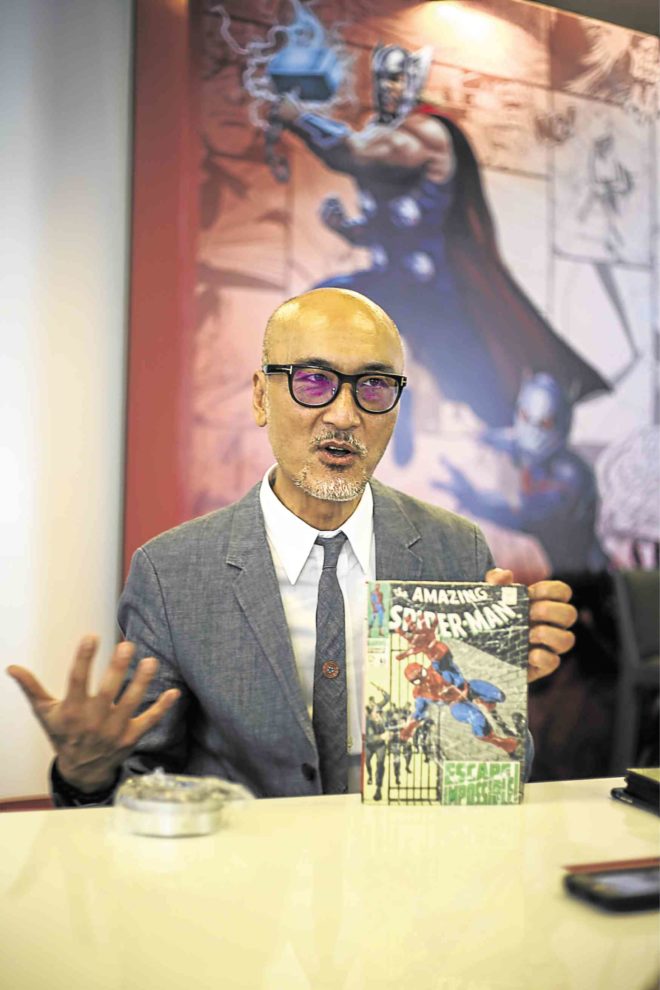
Yes, Allen Au-Yung handles much more than merchandise in his capacity as vice president, creative, for the Walt Disney Company Greater China, but the merchandise he masterminds is the clearest sign of how dominant Disney has become at the many things they do.
Promoting Disney is something Au-Yeung has basically been doing all his life, as proven by his vintage photo of a young Au-Yeng wearing a Mickey Mouse T-shirt.
Now, if it has Luke Skywalker, Lightning McQueen, Spider-Man and, of course, Mickey Mouse, on it and you bought it (admit it), Au-Yeung probably shepherded it from concept to the department store aisle. Au-Yeung has his fingerprints on every product that carries the icons of Disney’s big four franchises: Disney, Pixar, Star Wars and Marvel. Au-Yeung wowed fans at Marvel Creative Day Out with a presentation crammed with brilliant Disney merch, ranging from Princess Leia pouches to Star Wars streetwear to a full-sized Iron Man suit (you can buy all of it, even the suit). His is the vision that defines “product” when it comes to Disney in Asia. He sat down with Super to discuss how he makes the Disney consumer product line runs. Here are excerpts:
What is the best part of your job?
I think it’s inspiring people. I think as a creative that’s the best part of the job. You do nothing but get inspired when people know what you do. With this company, I learn so much by traveling. I’ve been with the company for 20 years working in different regions: London, Japan, now China. There’s that whole thing about learning for the company but also feeding my need to understand the world, so that’s truly amazing. So, yes, inspiring people, meeting with creative people, that’s the best part of my job.
There’s different merch for different markets. How much effort goes into tailoring the merchandise for the specific markets?
We spend a lot of effort to try and understand the local market trends. Within Disney, the work of localizing has been strong the past years it all comes back to understanding the consumer and provide what they need, instead of the other way around. So for me it’s very important we understand the market and localization is important for us.
What is the collective merchandizing thrust for Asia?
If you look at the history of our franchises—Marvel or even Star Wars—the understanding of those franchises compared to the Western world, we’re not there yet. Using product to grow affinity is very important. So in Asia, product tends to draw a lot more relationships with the franchises. We want people to understand: “What an fantastic product! What’s Marvel about it? What’s this character about?” With our products we want to expand creativity and curiosity about our franchises. So doing the right product is key. C.B. (Cebulski) was talking about lifestyle-driven product, instead of character-driven product. Functionality comes first, and then we figure out how story and trends are captured in the right product.
Which brand is the strongest or most popular in Asia?
I would say all the brands are equally strong but if you look at the history, Mickey Mouse is always strong and preferred by everybody. People come and they’re like: “I want Mickey Mouse.”
Star Wars and Marvel do have a lot of product, so is there an attempt to push these later brands?
Absolutely. That’s why the whole I wouldn’t say we never look at the lifestyle kind of stuff but this is what we focus a lot more on right now. We always believe that now, seven or eight years ago, we develop things for boys and girls. We think they like it, but it’s not all girls and boys. So, whatever we do, we have to be lifestyle-driven first. Whenever we put out a character or a story, all family and ages will like it anyway. So that’s the experience we have.
What area do you think holds great potential for Disney in Asia that has not yet been mined?
I think anything related to digital, I think we are bit slow at that. It’s different from market to market, but my understanding about China is that we are really lacking about how we can provide content and product for the digital platforms and for social media. That’s what we have to play more strongly going forward.